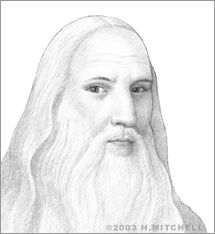Leonardo Vinci
Artist, inventor, musician, engineer and philosopher Leonardo da Vinci was born in the small Italian village of Vinci, outside Florence, on April 15, 1452. His parents were not married, though they later married different people and had 17 other children between them. Da Vinci lived with his father, and his surroundings were rich with the arts tradition of this area of Italy. He showed significant talent in art as a youngster and began an apprenticeship with Andrea del Verrochio in Florence when he was 15.
He stayed with Verrochio until 1477, when he moved from Florence to Milan and entered the service of the Duke of Milan. There, not only did he paint and sculpt, but he was also given the opportunity to design buildings and machinery. During this period he produced an impressive body of work that included designs for weapons, canals, many new types of machines and vehicles, possibly even the first design for a bicycle. His studies also encompassed anatomy, geometry, architecture, construction and mechanics.
Da Vinci’s Milan workshop is said to have been constantly buzzing with activity, new ideas and apprentices. However, he was always moving from one project to the next, and so he produced very few finished works of art, including "The Last Supper" and "The Virgin on the Rocks." Meanwhile, he kept meticulous records of his ideas in his many notebooks. His ideas, beautifully presented in artistic detail, have been referred to again and again through the last few hundred years, and continue to influence engineers and inventors today. Some of his ideas were not implementable at the time he came up with them, for the necessary materials and technology were not yet available.
Fascinated with clocks, da Vinci drew new designs for them that incorporated diamonds and semi-precious stones as well as new types of springs. He even invented an alarm clock whereby water would flow from one receptacle to another, and when the second was full, levers would raise his feet into the air, which worked to wake him at the desired stroke of the clock.
He also designed a lifting system or crane that could be used for quarrying or construction that would allow large blocks of stone to be moved easily. He designed tanks for military use, construction equipment, and the world’s first robot, with moving arms and legs. He was also interested in retractable and modular bridges, and designed several, including one to span a moat for the French governor of Milan. He was especially intrigued by the analysis of the components of machines, reasoning that if he understood how the various parts worked, he would be able to come up with a limitless number of combinations for machines of various uses. He also analyzed and classified the variety of screws available and determined their best applications, strengths and weaknesses.
Da Vinci left Milan in 1499 after the French invaded, and he traveled and worked all over Italy as an artist and engineer. In 1500, he worked in Venice, where he was trained in geometry and mathematics by Luca Pacioli. He went back to Florence the next year and concentrated on geometry further. In 1502, he began working as a military engineer. In 1503, he began working on perhaps his most famous work of art, the “Mona Lisa,” in Florence. During this period, he also wrote the “Codex on the Flight of Birds,” a dissertation on birds’ reliance on air currents and wind in flying, and how those elements worked in combination with the animals’ wing beats and tail movements. He compared air to water, and flying to swimming, and closely observed the anatomy of the flying fish. These studies lead to his designs for flapping-wing machines. He also designed the first flight instruments, including anemometers and hygroscopes.
In 1513, he moved to Rome, and worked on projects under commission of the Pope, such as bridges, rope-making machines, and anatomical and physiological studies. His patron, Giuliano de' Medici, died in 1516, and shortly thereafter King Francis I of France offered him the title Premier Painter and Engineer and Architect of the King. Da Vinci accepted this position and moved to Amboise, France. He died there on May 2, 1519.


